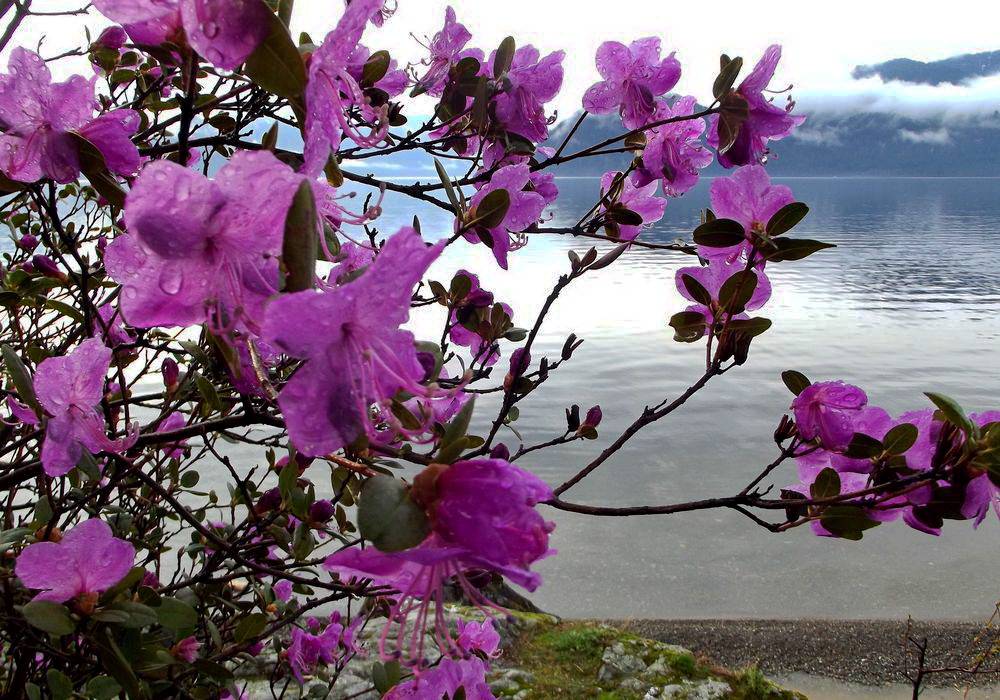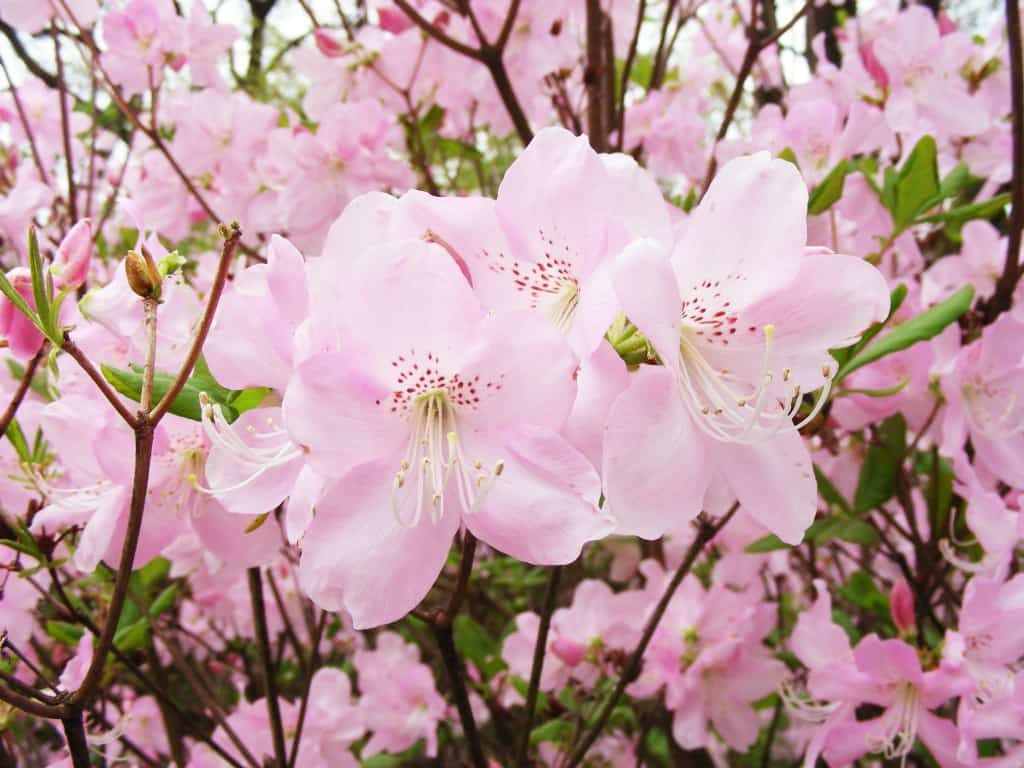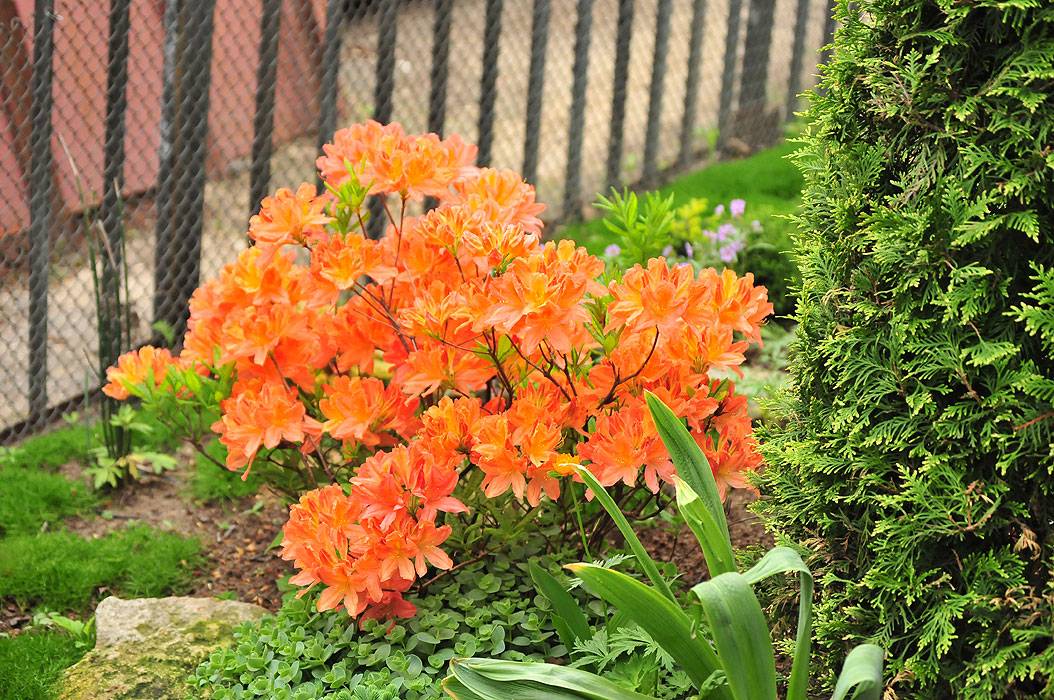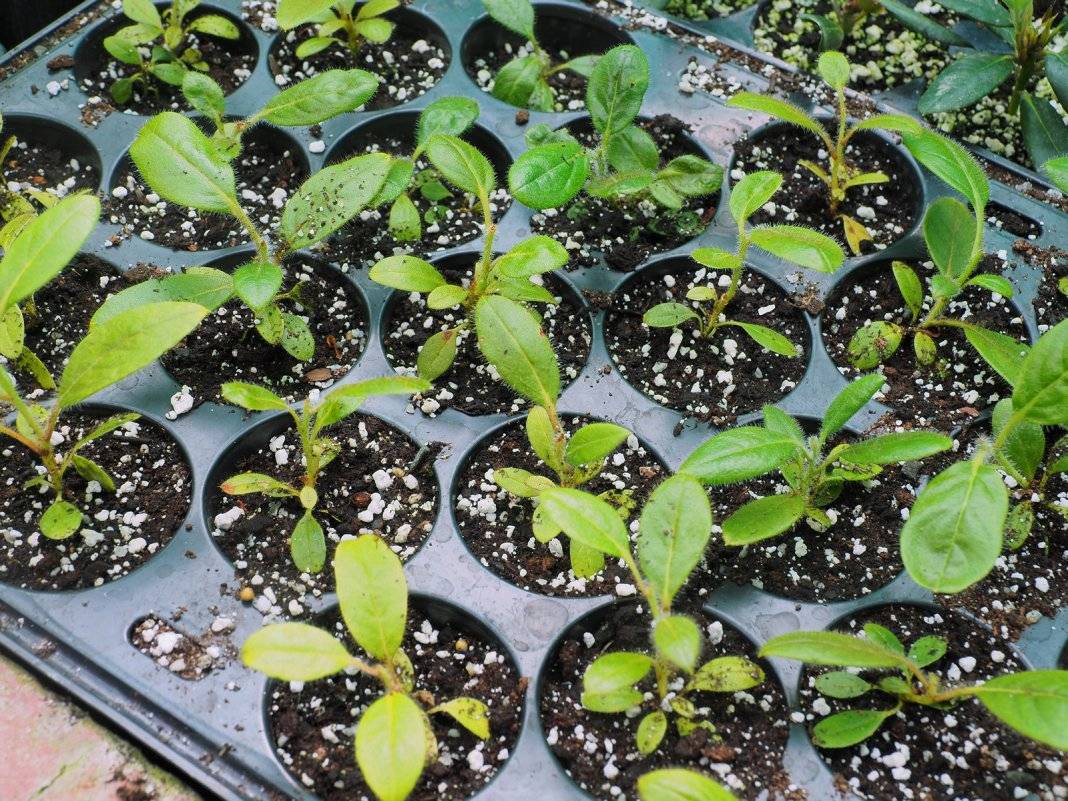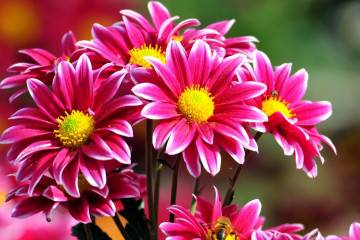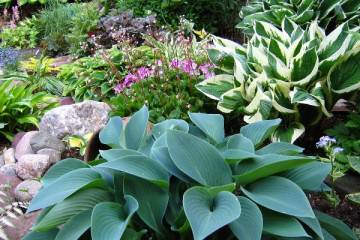Rhododendrons in the Urals: care and planting
Content:
Rhododendrons are distinguished by their bright flowering. In the Urals, the care and planting of crops require compliance with some rules. This is due to the cold climatic features. However, there are some varieties that tolerate temperature changes well and are often used as decorative ornaments.
Rhododendron varieties for cultivation in the Urals
Rhododendrons grow more slowly in the Urals than in other regions. However, in order for the plant to develop and please with exuberant flowering, it is necessary to choose the right type. The frost-resistant species include the following.
Daurian rhododendron is a bush that develops well, can reach a height of up to 2 m. Sprawling branches with small oval-shaped leaves. In autumn, some of the leaves fall off, the rest turns red. It begins to bloom at the end of April. Inflorescences are small pink or purple.
Ledebour is a bush no more than 1.5 m high. Its peculiarity is the preservation of foliage throughout the winter. However, in the spring, he dumps it before flowering. The culture blooms with purple buds. Thin shoots with oval leaves of dark green color.
Schlippenbach is a culture that reaches a height of up to 2.5 m. The shoots of the bush are thin with oval green leaves. Inflorescences are large pink.
Grandiflorum is a bush that retains the green color of shoots and leaves even in winter. Height can reach up to 3-4 m. Inflorescences are large lilac with small orange blotches.
Japanese rhododendron was developed for regions with low temperatures. The bush is up to 1.5 m high. Shoots are densely located. It begins to bloom in mid-May. The buds are large, light orange.
Lites is a bush that tolerates low temperatures down to -40 ° C. Reaches a height of 1.5 m. Spreading shoots. The color of the buds may vary depending on the variety.
Frost-resistant rhododendrons allow gardeners to get bright shrubs and enjoy a pleasant appearance.
How to propagate a rhododendron
Rhododendrons grow in the Urals on various types of soil. The culture can be propagated in different ways, depending on the species. The breeding method is chosen individually, based on the personal preferences of the grower.
Layers
Growing by this method does not require special skills. To carry out the procedure, you must:
- In spring, tilt the young shoot and sprinkle it with earth.
- Secure the maternal shoot and water it regularly.
- A year later, a young sprout will appear at the point of contact with the soil of the shoot, which must be dug up and transplanted to a new place.
Seeds
Reproduction using seeds is carried out as follows:
- Prepare a container with peat mixed with sand, pour plenty of water.
- Plant the seeds into the ground in shallow holes.
- Sprinkle with soil and cover with glass on top.
- Open the beds every day for a month and maintain the moisture level in the soil.
- After the emergence of seedlings, dive the seedlings into separate containers and put them in the greenhouse.
- Grow a seedling throughout the year, and then transplant it into the ground.
Seeds must be purchased only in proven places that sell planting material.
Cuttings
This method is used for plants that are more than 4-5 years old. To use this breeding option, you must perform the following algorithm of actions:
- In the spring, before the buds appear, it is necessary to prepare cuttings up to 10 cm long.
- The cuttings are placed in a growth activator for 2 hours. A root preparation is used.
- Mix peat and sand in a 2: 1 ratio and plant the planting material.
- Top with a glass container or cut-off plastic bottle.
- Water regularly for 3-4 months.
- Transplant into seedling containers and leave until spring.
In the spring, cuttings are transplanted into open ground.
Rhododendrons in the Urals: care and planting
Planting rhododendron seedlings and caring for crops in the open field in the Urals is not difficult. However, it is necessary to observe some peculiarities in the choice of planting material.
Site selection and soil requirements
Planting a seedling is carried out in a wide hole no more than 40 cm deep.
When choosing a landing site, it is necessary to give preference to areas with diffused sunlight. Most often, shrubs grow on the lower tier under tall trees. However, with full shading, they practically do not bloom and develop poorly. You cannot plant them in drafts.
The soil at the planting site should be of high acidity. Humidity should be neutral, drainage is done when water accumulates, otherwise the roots will rot. The soil should be loose and oxygen-permeable.
Sapling selection
When choosing a seedling, you must carefully examine the bush for rot and damage. The root system must be closed. Most often, home seedlings are used, which allow you to preserve all the characteristics of the selected variety.
It is quite possible to get healthy bushes at low temperatures. Rhododendrons in the Urals, planting and caring for which require compliance with agrotechnical rules, will delight you with their flowering for a long time. We are talking about timely watering, top dressing and protection from pests and diseases.
Loosening and mulching
It is necessary to loosen the soil before each watering. This allows oxygen to penetrate into the deep layers and reduces the risk of rot in the root system.
It is recommended to mulch using coniferous needles. Such a cover retains moisture and oxidizes the soil.
Watering and feeding
Watering is carried out twice a week. For the normal growth of the bush, average soil moisture values are used. Therefore, at least 10 liters of water must be poured under each adult bush.
Top dressing is carried out according to the following scheme:
- in the spring, nitrogen fertilizers are applied, which stimulate growth;
- after the end of flowering, superphosphates or complex fertilizers are applied.
In autumn, it is not recommended to feed the bushes, as the formation of new shoots may begin, which will die at low temperatures.
How to prepare a shelter for winter
Before the onset of cold weather, it is necessary to prepare the plant. To do this, the bush is abundantly watered and all damaged shoots are removed.A plastic bag or a layer of straw is used as a cover. The bush leans towards the ground and all shoots are covered. When covering the bush, it is necessary to make holes for air penetration.

Shelter bushes for the winter is an important condition for growing in the first 3 years after planting.
Diseases and pests
To properly grow rhododendrons, it is necessary to timely control pests and diseases.
Among the parasites, snails and slugs are especially annoying. You can eliminate them mechanically. Often young shoots and leaves damage aphids and scale insects. Insects are removed using special insecticides or soap solution.
Among diseases, rhododendron is threatened by spotting on the leaves. The disease can be cured with Bordeaux liquid. Rot is also common. The damaged area must be removed and watering reduced.
Growing rhododendrons will not be difficult if you choose the right planting material. To get a beautiful bush that will tolerate weather changes well, it is important to choose the right variety. When choosing a seedling, preference should be given to bushes without damage and rot. After planting, attention must be paid to further care. It is important to water the seedlings in a timely manner and apply nutritious fertilizers. Subject to these rules, culture will be a decoration of the site and a part of landscape compositions even in the Urals for many years.


